#all american comics
Text
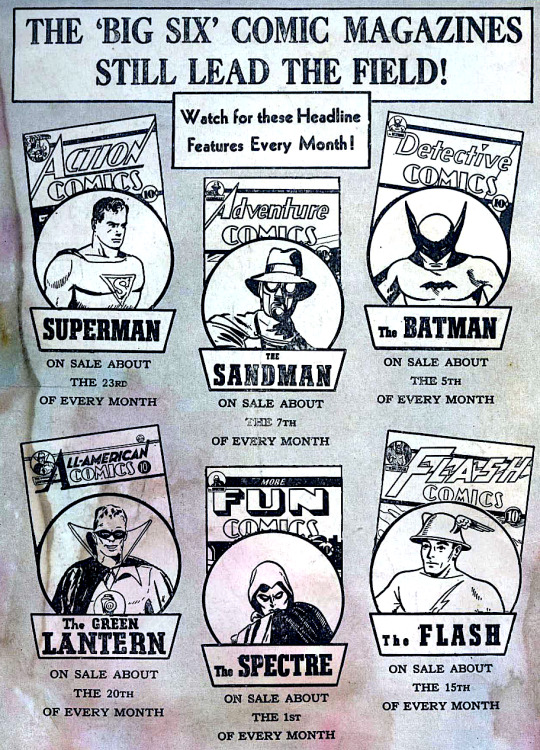
The "Big Six" from Flash Comics #15 (1941)
#superman#sandman#batman#green lantern#spectre#the spectre#the flash#flash#jay garrick#alan scott#bruce wayne#kal el#clark kent#action comics#all american comics#flash comics#adventure comics#more fun comics#detective comics#dc#golden age#comics#dc comics#40s comics#40s#comic ads#comic ad#the lads!#can i find any readable golden age spectre and sandman scans ?
122 notes
·
View notes
Text
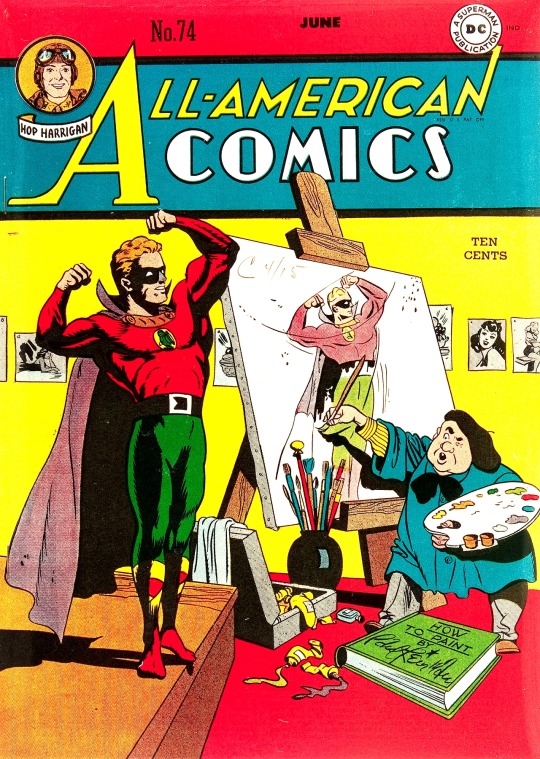

Alan Scott in All-American Comics (1939) #74 cover by Paul Reinman // Private commission by Darryl Banks.
#alan scott#doiby dickles#kyle rayner#green lantern#jsa#justice society of america#all-american comics#all american comics#all-american comics 1939#paul reinman#darryl banks#dc#dc comics#u can reblog#just thought this was extremely funny & delightful. the gay ass pose hes doing for doiby <3
31 notes
·
View notes
Text

October 1944. Born on Monday: The debut of one of the most fearsome of DC's Golden Age villains, the monstrous Solomon Grundy, in a story written by noted science fiction author Alfred Bester. Although he looked like Universal's Frankenstein Monster (then appearing with Dracula and the Wolf Man in a popular series of monster movies), Grundy was actually a kind of swamp monster, built around the skeleton of murdered miser Cyrus Gold. As Green Lantern explains:
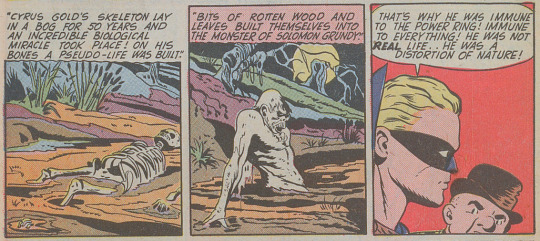
Grundy's origin is very similar to that of the Hillman Comics muck-monster The Heap, who had first appeared in the Sky Wolf story in AIR FIGHTERS COMICS #3 (December 1942), although the Heap had originally been a WW1 German flying ace, Baron Emmelmann. (The Heap later inspired Swamp Thing and Man-Thing.) However, all of these characters ultimately had their roots in a Theodore Sturgeon short story called "It," first published in the pulp magazine UNKNOWN in 1940.
Because Solomon Grundy is immune to Alan's power ring (which didn't work on wood), Alan eventually deals with him by shoving the monster in front of an oncoming freight train. However, as any horror movie fan could tell you, it's not so easy to kill something that's dead to begin with. Grundy would return three more times in the Golden Age, next appearing in the Green Lantern story in COMIC CAVALCADE #13 (Winter 1945).
#comics#all american comics#paul reinman#alfred bester#green lantern#alan scott#solomon grundy#doiby dickles#swamp thing#the heap#man thing#muck monster#theodore sturgeon
33 notes
·
View notes
Text

Vintage Comic - All-American Comics #093
Pencils: Irwin Hasen
Inks: Irwin Hasen
DC (Jan1948)
#Comics#DC Comics#All American Comics#Green Lantern#Irwin Hasen#Alan Scott#Harlequin#Vintage#Art#DC#Mutt And Jeff#Rockets#1948#1940s#40s
57 notes
·
View notes
Text

"100th Smash Issue!"
"The roar of thunder and the flash of lightning signal the entrance of the sensational new Western fighting team Johnny Thunder and Black Lightning!"
Celebrating the 100th issue of All-American Comics by introducing western feature Johnny Thunder. The mag would be renamed All-American Western with issue #103. Super-heroes were out, western heroes were in.
All-American Comics #100, August 1948, cover by Alex Toth
15 notes
·
View notes
Photo
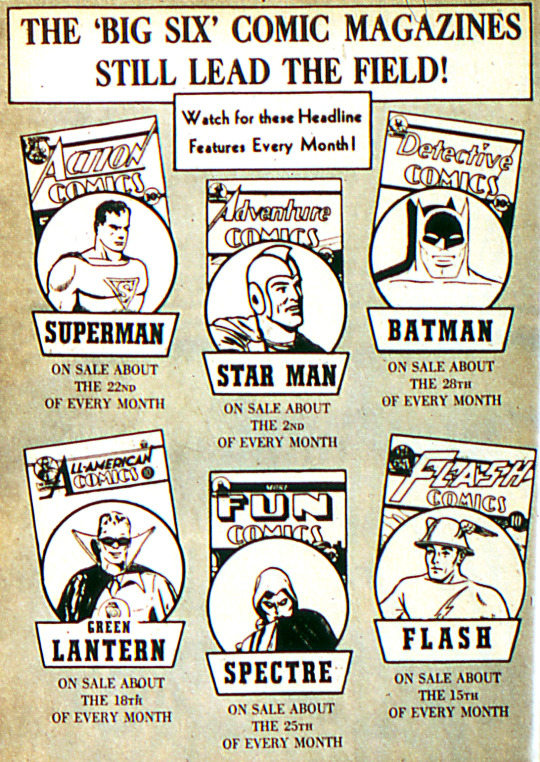
House-ad for the ‘big six’ National Comics/All-American Comics titles from April 1941.
#all-american comics#all american comics#green lantern#alan scott#more fun comics#the spectre#jim corrigan#flash comics#the flash#jay garrick#detective comics#batman#bruce wayne#adventure comics#starman#ted knight#action comics#superman#clark kent#national comics#dc#dc comics#house-ad#house ad#40s
54 notes
·
View notes
Text

All-American Comics (1939) #16 spotted in The Accountant (2016) dir. Gavin O'Connor
8 notes
·
View notes
Text

#flash comics#sensation comics#all american comics#action comics#detective comics#adventure comics#star spangled comics#fun comics#dc comics#golden age comics#40s comics#Wonder Woman#the flash#superman#batman#green lantern#the sandman
24 notes
·
View notes
Photo

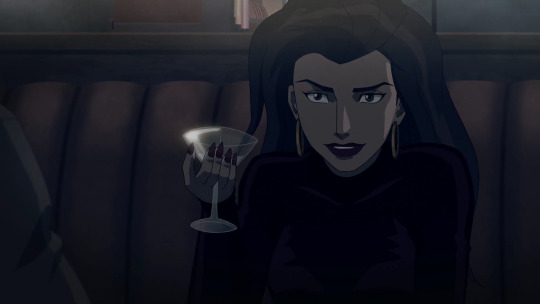



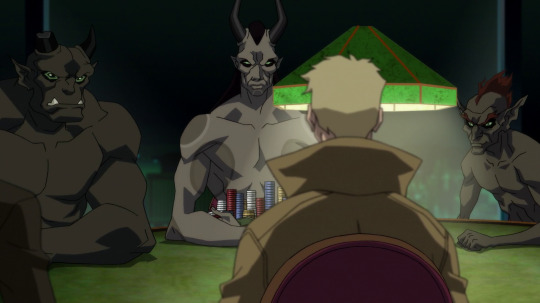

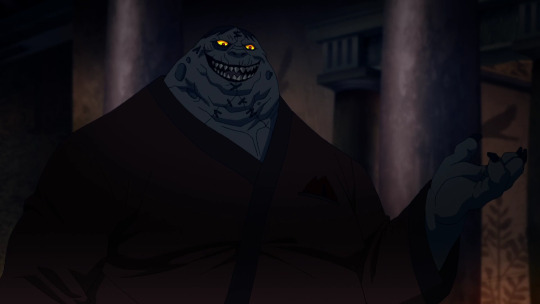

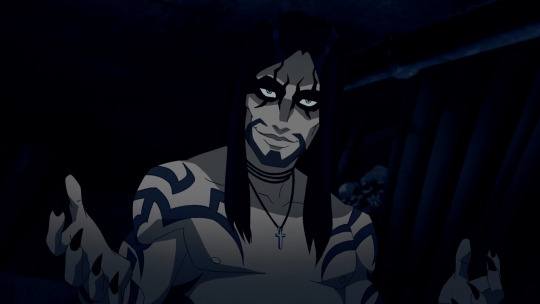
The gods, demons, dieties and occultists from the DC Animated Movie Universe. In order:
Nabu - First appearance in More Fun Comics #67 (1941). Appears in Suicide Squad: Hell to Pay (2018).
Angela, the Queen of Angels - Only appearance in Constantine: City of Demons (2018).
Trigon - First appearance in The New Teen Titans v1 #2 (1980). Appears in Justice League vs Teen Titans (2016) and Justice League Dark: Apokolips War (2020).
Destiny - First appearance in Weird Mystery Tales #1 (1972). Appears in Justice League Dark (2017).
Solomon Grundy - First appearance in All-American Comics #61 (1944). Appears in Justice League vs Teen Titans (2016).
The Demons Three - First appearance in Justice League of America v1 #10 (1962). They appear in Justice League Dark (2017).
Nergal - First appearance in Hellblazer #6 (1988). Appears in Constantine: City of Demons (2018).
Beroul - First appearance in John Constantine - Hellblazer: All His Engines (2005). Appears in Constantine: City of Demons (2018).
Mictlantecuhtli - First appearance in Action Comics v1 #613 (1988). Appears in Constantine: City of Demons (2018).
Alex Logue - First appearance in Hellblazer #11 (1988). Appears in Constantine: City of Demons (2018).
#dc#dc comics#dcamu#dc animated movie universe#detective comics#action comics#john constantine#constantine#hellblazer#vertigo comics#hell blazer all his engines#constantine all his engines#beroul#alex logue#mictlantecuhtli#justice league of america#all american comics#more fun comics#nabu#doctor fate#dr fate#nergal#the demons three#solomon grund#cyrus gold#justice league vs teen titans#justice league dark#constantine city of demons#weird mystery tales#destiny
19 notes
·
View notes
Photo
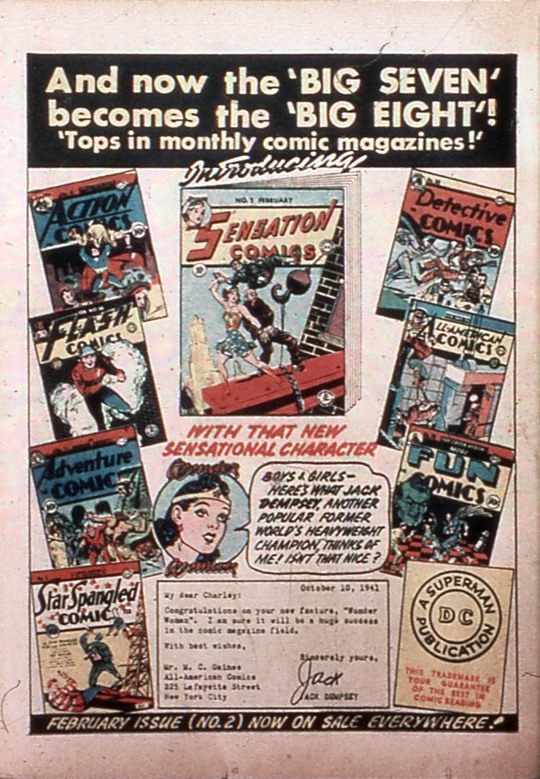
1942 DC Comics House Ad hyping up the new superhero, Wonder Woman for Sensation Comics #2
#all american comics#sensation comics#wonder woman#dc#dc comics#dc comics house ad#comic ads#comic house ad#comics#all star comics
14 notes
·
View notes
Photo
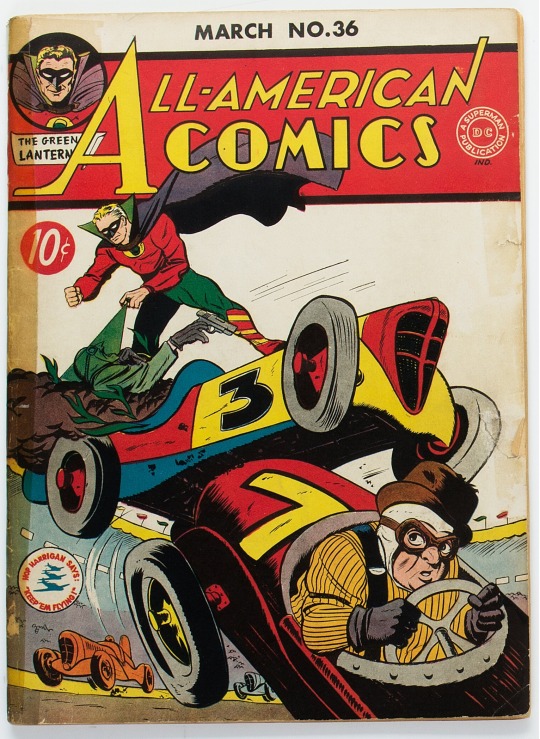
''All American Comics'' N°36 (DC, 1942). Couverture de Martin Nodell et Irwin Hasen - Source Heritage Auctions.
15 notes
·
View notes
Text

All-American Comics #26 (1941) by Bill Finger & Irwin Hasen
54 notes
·
View notes
Text

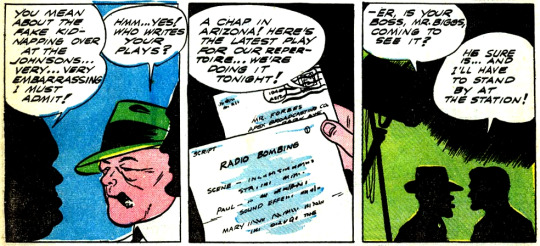




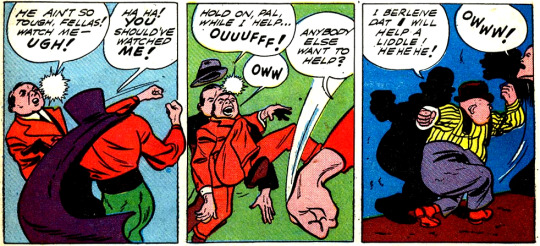


Ha ha! You should've watched me!
Alan Scott in All-American Comics (1939) #39
(Bill Finger, Mart Nodell & Irwin Hasen)
#alan scott#doiby dickles#green lantern#jsa#justice society of america#justice society#all-american comics#all american comics#all-american comics 1939#bill finger#mart nodell#irwin hasen#dc#dc comics#dcedit#comicedit#comicsedit#u can reblog#GET EM DOIBY!!!!!!!!!!!!!!!!#one of alans funniest lines this ended me
12 notes
·
View notes
Text
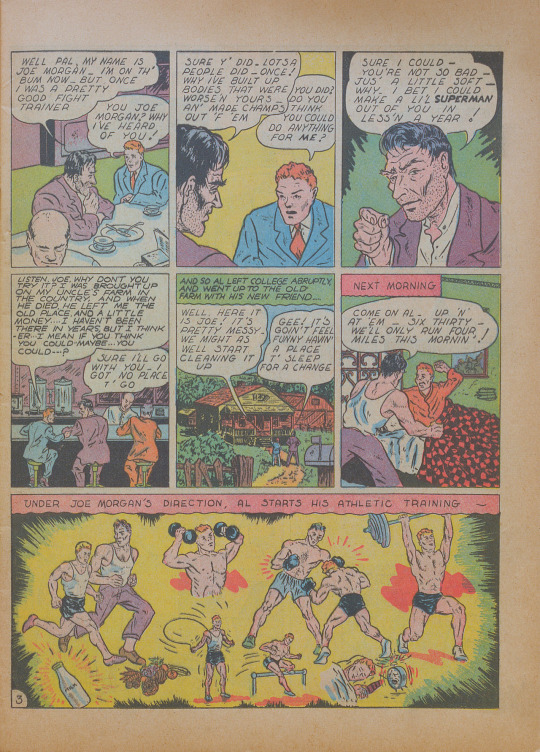
October 1940. Third on the list of original JSA members who didn't seem straight was Al Pratt, the Golden Age Atom. Al was a student at Calvin College, constantly pushed around for being short and skinny (and implicitly for being Jewish, although that was never spelled out) and rudely dismissed by a girl he liked, Mary James, as a "spineless little amoeba." Dejected, Al buys dinner for a washed-up boxing trainer named Joe Morgan, who suggests that he can "make a li'l Superman" of Al in less than a year. Al suggests that the two of them go to live on his uncle's old farm, where they spend the next year in an intense training regime to build Al's physique.
It's important here to note a conundrum in the popular attitudes of this period: While boxing was considered an appropriately macho pursuit, interest in "physical culture" for its own sake was more suspect and might well have been read as gay (in part because fitness magazines were a way to see nude or mostly nude men that might get past the censorship and obscenity laws of the time). Also, the context is suggestive: Al drops out of college for an entire year to live with a man at least twice his age and spend a lot of time getting mostly naked with him to train. Moreover, after a year, Al expresses his wish for Joe to continue living with him:
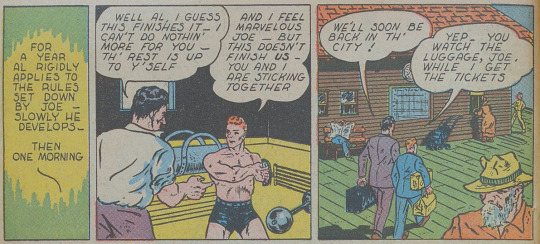
In the subsequent issue, Al — who is now so strong he keeps accidentally breaking things — has apparently given up on Mary James, although Joe gives him a push in that direction. Joe seems self-conscious about the age difference between him and Al (and presumably the other Calvin College students in their area), but he and Al continue to live together for a few months. By ALL-AMERICAN COMICS #30 (September 1941), Joe has apparently moved out and started his own health camp. Al resumed his pursuit of Mary, although she was still often contemptuous of him as too meek and timid, unaware that he routinely put on a mask to beat people up and fight crime. They were still dating as of the Atom's final Golden Age solo appearance in FLASH COMICS #104 in 1949.
The modern retelling of the Atom's origin in SECRET ORIGINS #25 makes some changes to the Golden Age version, suggesting that Al merely spent weekends with Joe on the farm for a year rather than living there with him, and asserting that Joe left as soon as Al became the Atom rather than months later. However, in this version, Joe's departure reduces Al to tears and sobbing:

(As alluded to in the above panels, ALL-STAR SQUADRON Annual #1 (1982) tried to link the origins of the Atom, Wildcat, and the Guardian by claiming that Joe Morgan had a split personality and trained all three men under different names. This didn't make a lot of sense — the man who trained Ted Grant, "Socker" Smith, was a heavyweight champion prizefighter, not a trainer, and the origin of Wildcat involved Ted inadvertently killing Smith in the ring after gangsters slipped a poisoned needle into his glove!)
Al Pratt's Silver Age guest appearances in THE ATOM indicate that he was still single by 1968 — THE ATOM #36 has some of his married friends trying to fix him up, and he thinks to himself, "I've been so busy as the Atom in the past--I've sort of let romance pass me by!" Modern stories established that he and Mary James were married for a while, although she died a few years later, and that Grant Emerson (Damage) was their son (although Al thought the boy died as an infant). However, it's hardly uncommon for gay or bisexual men to marry women or even have kids, and the sight of Al sobbing at the departure of Joe Morgan doesn't make it seem like his feelings for Joe were exactly platonic, even if you don't want to read too much into their training montage and cohabitation.
#comics#all american comics#secret origins#all star squadron#bill o'connor#ben flinton#roy thomas#mike clark#bob downs#the atom#al pratt#joe morgan#justice society of america#jsa#dumb retcons like that tended to drag down all star squadron#which is both obsessed with golden age minutiae#and also surprisingly inconsistent with the content of the actual golden age stories#(which to be fair were less readily available in the 1980s)#al pratt also died in zero hour#so this is another case where saying he was gay or bisexual#would be unlikely to produce much controversy#“Al who?”#people claim to see smoldering chemistry in very casual character interactions#but it doesn't take a huge stretch to see this as al's college relationship with an older man
19 notes
·
View notes
Text


#adult collectors#adult collectibles#collectables#figures#funko#funko pop#pop comic covers#green lantern#1st appearance#all american comics#walmart exclusive#dc comics#DC#dc universe#WB#warner brothers#dc multiverse#dcu#dc collectibles#comic covers
3 notes
·
View notes
Text
The Green Lantern Legacy - All-American Comics #52 Cover By Paul Reinman and Sam Burlockoff - Cover Date September 1943

11 notes
·
View notes